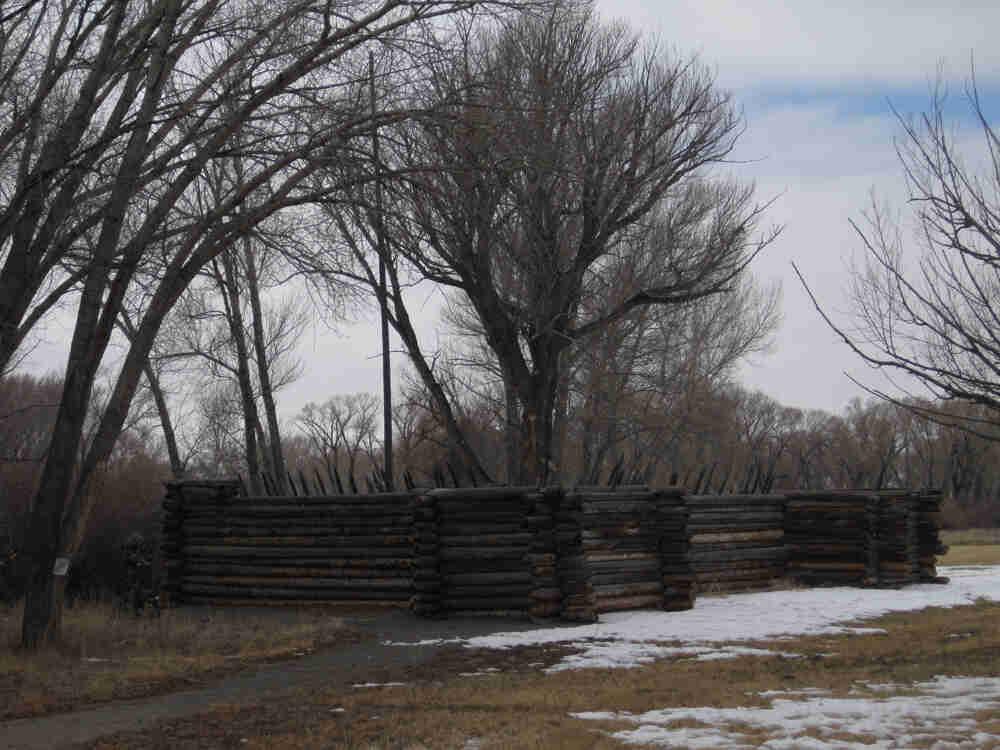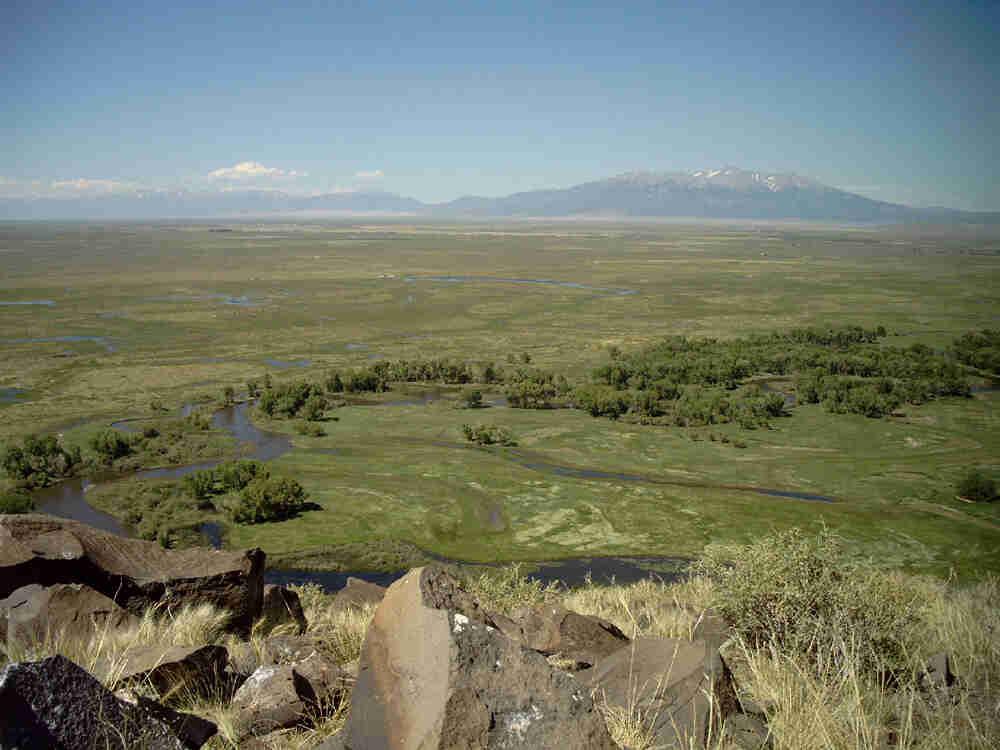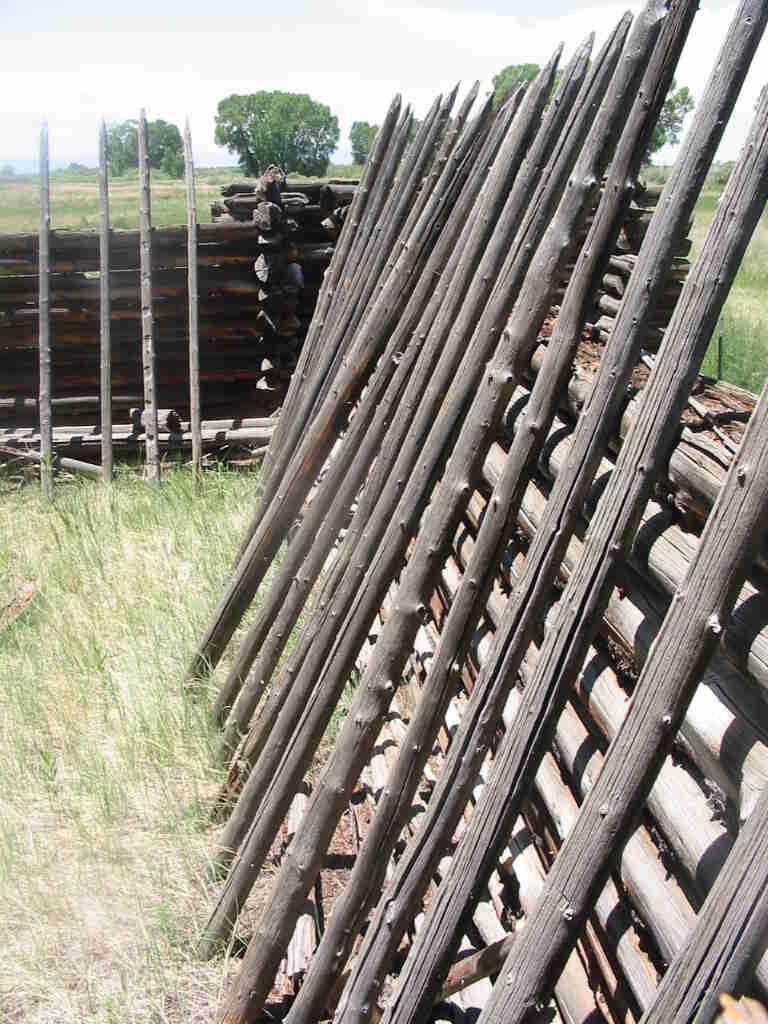Pike’s Stockade
Full Article
The Pike Stockade is a reconstruction of a small fortress built by the soldiers of the 1806–7 Zebulon Pike expedition. It is located on the Rio Conejos, a tributary of the Rio Grande, in the San Luis Valley, seventeen miles southeast of Alamosa. Administered by History Colorado, the stockade commemorates one of the first documented structures built by Americans in what is now Colorado. More broadly, it testifies to Colorado’s role in North American exploration in the era of Thomas Jefferson, Lewis and Clark, and the Louisiana Purchase.
Pike Expedition
After six grueling months of travel from St. Louis, Pike and his crew of nine American soldiers and one civilian arrived at the mouth of the Conejos on January 31, 1807. They ascended the stream several miles and camped there for the next month. In selecting the site, Pike sought timber, defense against potential Indian hostilities, and a base from which to rescue five frostbitten men he had left behind in the mountains earlier that month. Although his journal did not mention it explicitly, he also undoubtedly wanted access to water and game. The well-timbered spot on the Conejos at the foot of the 600-foot rise of Sierro del Ojito, a promising lookout point, fit the bill. Additionally, a hot spring nearby keeps water flowing year-round.
Pike’s journal, which he later published, describes the construction of a “small fortification.” According to a footnote in his entry of February 6, the structure was “36 feet square” and made of “heavy cotton-wood logs, about two feet [in] diameter.” The structure rose to a height of twelve feet and had sharpened outward-pointing pickets to deter attackers. Its south face abutted the river, and the men dug a moat that encircled the stockade. To enter and exit, they crawled through a small hole at the base. Satisfied, Pike raised an American flag over the stockade.
While Pike awaited the return of the rescue party, some Spanish dragoons arrived on February 26, though they were considerably less threatening than the marauders who haunted Pike’s imagination. Their commander informed Pike that the Americans were camped in Spanish territory and insisted that Pike and his men accompany him to Santa Fé to answer to the Spanish governor. After minimal protest, Pike consented. He left two men at the stockade with a detachment of Spaniards to wait for the rescue party’s return.
He would not return to the United States until July 1, when the Spanish escorted him and his men back to Fort Claiborne in present-day Louisiana.
Did They Actually Build It?
In his 1978 book, Pike in Colorado, San Luis Valley historian Carrol Joe Carter raised the question of whether Pike and his men actually built the fort. Although detailed in describing the completed structure, Pike’s journal was vague about the construction process, recounting it only with phrases like “We continue to go on with the works of our stockade,” and “labored at our works.”
Carter, however, thought the structure as described by Pike exceeded the basic shelter the men really needed. Pike, he wrote, “had no reason to fear attack” from Spaniards or Indians. Carter also doubted whether the party had the necessary equipment to construct something so substantial, noting that when the Spaniards later sold his tools at auction, axes, adzes, and shovels were not among the items listed. Nor, he said, did Spanish documents comment on the existence of a fort. Finally, Carter maintained, the men were too few and too weak for heavy labor. Carter theorized that the officer Pike and the gentleman civilian were unlikely to do manual labor. That left only nine men, already exhausted from arduous mountain crossings, to fell, haul, and hoist thirty-foot timbers and hack a ditch into the frozen ground. After the departure of the rescue party, this number dwindled to four. Thus, Carter concluded that the men likely constructed something more modest, along the lines of what they had erected twice before on the expedition. Pike’s journal provided no details of these structures, but they appear to have each been thrown up in a day.
Carter, however, offered no motive for why Pike would have wanted to lie about a fort he never constructed. Moreover, any of the men would have been able to contradict any falsehoods he published. In addition, Pike did genuinely worry about attackers. He had seen no Indians since meeting an aggressive war party on November 22, but he had seen plenty of signs of them. Moreover, neither that encounter nor his time among the Pawnees in the fall had gone smoothly. He also believed (erroneously as it turned out) that Spanish soldiers had trekked from Santa Fé the previous fall to thwart his expedition. Perhaps the stockade surpassed what he needed, but it did not exceed what he feared. And, as even Carter noted, occupying bored men with work would have boosted morale—it was not as if they had much else to do.
As for tools, nearly a year elapsed between his arrest in the San Luis Valley and the auction in Chihuahua, more than 800 miles away. This was plenty of time and space for an axe or two or other items to be lost or broken or to fall into the hands of an opportunistic Spaniard.
Carter may also have overestimated the severity of the men’s condition. While Pike’s journal repeatedly discussed his comrades’ failing conditions between January 17 and 27, after that he ceased all mention of hunger, frostbite, fatigue, and other ailments. Possibly the men were recovering. He went hunting frequently, so at the least, the party enjoyed a healthy supply of meat. Moreover, while Carter doubted the frozen ground would allow for a moat, Pike, who had carefully chronicled poor weather in the weeks before, made not a single reference to cold while camped on the Conejos. Although the region’s winter temperatures can dip well below freezing, a warm February in 1807 that softened the earth and made a ditch feasible would not be out of the question.
Finally, it is true that the Spaniards did not comment on the fort, but they did not comment on much of anything else either. The record is silent on just about all details of the encounter. While an absence of evidence can raise doubts, it cannot prove the fort was not built.
Restoration
Whether Pike built the fort or not, the people of Colorado have taken a keen interest in commemorating his visit to the San Luis Valley. Late nineteenth- and early twentieth-century lore among valley old-timers testified to stockade debris remaining at the site and a depression in the ground possibly marking the moat. Subsequent archeological investigations, however, have found no corroborating evidence.
Efforts to preserve the site began with historian D. E. Newcombe raising a flag there in 1910 and convincing the US Army to survey the area. Not surprisingly, given the history of flooding and the perishable construction materials, no evidence of the fort was found. The army report did, however, confirm the location.
Beginning in 1924, the Colorado State Historical Society (today known as History Colorado) took an interest in the site. The society’s Albert B. Sanford called it “almost sacred ground.” In 1926 he arranged for the state to purchase 120 acres to be preserved as Pike’s Stockade Park. That year, riprapping and a dam were installed to reduce erosion.
A permanent plaque and monument were installed in 1936, and 600 people gathered with Governor Edwin C. Johnson for a celebratory picnic. In 1946, the legislature appropriated $5,250 for the site, and the historical society began planning a replica stockade in 1947. In 1949, thanks to a donation from W. A. Braiden, the society purchased another 840 acres, including Sierro del Ojito. Additional lands were acquired in the 1950s.
The stockade replica was completed in 1952. It followed Pike’s specifications, with the exception of substituting more durable spruce logs in place of short-lived cottonwood ones. The following year Pike’s Stockade Park was named a State Historical Monument, and in 1961 the stockade was designated a National Historic Landmark.
Today
Today, History Colorado manages the site as an adjunct to Fort Garland Museum. In addition to the reconstructed stockade, it has interpretive plaques, monuments commemorating the expedition, restrooms and picnic facilities, and paths through the riparian forest and along the river. Its wintertime closure, remote location at the end of several miles of unpaved road, and swarms of summertime mosquitos make it a lightly visited place. Visitors who brave the obstacles, however, enjoy serenity, lush greenery, and good birding. And with just a little imagination, they can transport themselves back to 1807 and the earliest days of American exploration as they walk the very ground trod by Zebulon Pike and his comrades. Quietly, the stockade and its surroundings testify to an era when Colorado was contested among Americans, Spaniards, and Native Americans, and when its character and contents were still tantalizing mysteries to Euro-Americans.
































